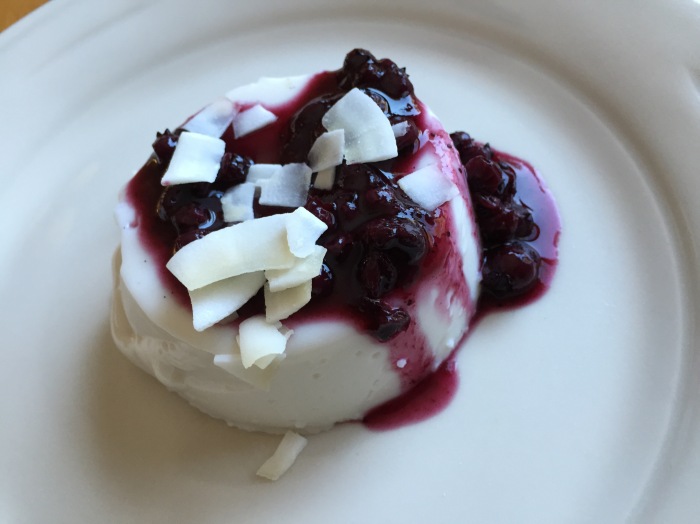Posts Tagged ‘kosher’
Irish Moss Blanc Mange and Panna Cotta with Agar-Agar: Vegan Seaweed Says Move Over, Gelatin!

Coconut milk panna cotta, congealed with agar-agar instead of Knox gelatin. (From Heidi Swanson’s “Super Natural Cooking,” recipe ran with my Portland Press-Herald column here.)
As longtime readers of this blog will remember, luscious Italian panna cotta is one of my favorite desserts. I guess that reveals I’m not much of a baker, but I just love how unflavored gelatin coaxes this creamy dessert into an addictive, jiggly texture upon chilling. Still, years ago, when I posted my panna cotta recipe, a vegetarian friend had asked about a suitable non-animal substitute for gelatin that’s since haunted me. She wondered if pectin would work. I found a packet of seaweed-derived agar-agar at an Asian market about that time, but never used it. Its package indicated it would congeal juicy, sugary desserts just like gelatin.
Then I heard about a new (well actually very old-time) technique for congealing milk puddings at this revelatory, delicious seaweed cooking class I took through UMaine Extension in February. Several women in the class waxed nostalgic about how their Maine grandmothers gathered washed-up Irish moss seaweed on the coast to boil into the congealed dessert blancmange. Their enthusiasm inspired my latest The Farm-to-Table Family column for the Portland Press-Herald: “Who Needs Boxed Jell-O When Maine Seaweed Abounds?” (Heidi Swanson’s coconut milk panna cotta recipe is excerpted there.) In that article, I promised to give readers an Irish moss blanc-mange recipe on my blog. Here it is below the picture:

Red algae Irish moss seaweed is boiled with milk in lieu of animal gelatin to make the old-fashioned pudding, blanc mange. It thrives on the Maine coast and is the source of the ubiquitous food additive carrageenan, long extracted here at a plant in Rockland. (Image from Wikipedia)
Irish Moss Blanc-Mange Dessert Pudding
This recipe come from Prannie Rhatigan’s esteemed “Irish Seaweed Kitchen” cookbook. Maine seaweed harvester Kelly Roth of VitaminSea in Buxton told me, “It’s pretty much our bible,” with wide-ranging recipes for incorporating seaweed into quotidian cuisine, from mashed potatoes to pot roast. Rhatigan’s recipe comes from the “hallowed kitchens” of the Ballymaloe House in County Cork, Ireland. Hence the the metric system measurements. You can order dried Maine Irish moss from the websites of local harvesters Maine Coast Sea Vegetables out of Franklin, or VitaminSea from Buxton.
Serves 6
3.5 to 4.5 grams Irish (carrageen) moss, depending on variety (Kelly Roth recommends using the dried seaweed, soaked in fresh water to remove ocean salt)
1 1/2 pints (850ml) milk
1/2 teaspoon vanilla extract or vanilla bean pod
1 1/2 ounce (50g) sugar
1 egg, separated
1. Soak the carrageen (Irish moss) in cold water for 10 minutes, then remove and put in saucepan with milk and a vanilla pod, if using.
2. Bring to the boil and simmer very gently for 15 minutes, semi-covered, taking care that it does not boil over.
3. The carrageen (Irish moss) will now be swollen and exuding jelly.
4. Pour through a strainer into a mixing bowl.
5. Rub the jelly through a strainer and beat it into the milk with the sugar, egg yolk and vanilla essence, if using.
6. Whisky egg white stiffly and fold it gently into the mixture; it will rise to make a fluffy top. Transfer to serving bowl.
7. Serve chilled with a fruit compote (strawberry-rhubarb would be ideal when the season comes late this spring), or a sweet sauce. I served the above coconut milk panna cotta with my Maine wild blueberry-maple syrup preserves.

Found at health food stores and Asian markets, seaweed-derived agar-agar is a good vegan substitute for gelatin.
Heidi Swanson’s Coconut Milk Panna Cotta congeals with seaweed-dervived (from a red algae source similar to Irish moss) agar-agar that I found at my local natural foods store. Use this if you don’t have access to Irish moss. Japanese native, Hiroko Meserve, a mom here in Brunswick, told me she uses agar-agar (called kanten in Japanese) to gel fresh grapefruit juice desserts and also to make the popular Japanese red bean paste sweet, yokan. Agar-agar also gels the popular Chinese almond milk (technically made with apricot kernel, traditionally) pudding know as annin tofu. It masquerades as tofu, when cut into white cubes before serving.
We all know kids love the color and taste of Jell-O. It’s inspiring to discover they love seaweed just as much, and desserts congealed with agar-agar instead of gelatin. I found this out when I went into my son’s preschool last week to read this “Aquaculture for ME” book put out by the Maine Agriculture in the Classroom program. Theo is now obsessed with this book and requests it most nights at bedtime. This program is funded by those Maine agriculture license plates we are proud to sport on our Subaru–get yours today!
I brought the preschoolers a snack of blueberry-kelp smoothies (made with dried Maine kelp I soaked and rinsed of salt) and 100 percent fruit juice vegan Jell-O, thickened with only agar-agar (follow the easy instructions on the package). They particularly gobbled the later up.
Chicken Feet

It's so carnal to chop the claws off the parboiled human-like feet. And use a paring knife to cut off the black claw pads.
Leg of lamb apparently isn’t kosher. I learned so much while bragging to my husband’s grandmother that I was making her grandson lamb for a seder. I thought the whole lamb was fair game for Passover. Apparently, the leg is too close to the hoof. But chicken feet are sound? I’ll never understand that logic. Don’t even get me started on the prohibitions against bugs on organic produce.
I wanted to make from-scratch chicken stock for matzo ball soup, so what better time to finally try making stock from chicken feet. I turned to a local source of pastured poultry, Afton Field Farm. They only had one bag of the feet left from last year’s processing. Restaurants buy them up for chicken broth. Unfortunately, the feet were freezer-burned because their claws ripped through their plastic bag. That’s why they’re hard to store. I’ll have to go back for fresh ones when chicken slaughtering begins end of May.Prepping the feet is a bit of a potschke. You must par-boil them, chop off the claws at the joint and, with a paring knife, remove any blackish remaining claw pad. The process gets you in touch with your carnivorous–almost cannibal-like–side, given that peeled chicken feet somehow resemble human hands.

But the collagen-rich broth was delicious and as gelatinous as Jello when refrigerated (is that Manischevitz suspends its jarred gefilte in?). I diluted it with peppery chicken-back stock so nothing tasted out of the ordinary. Chicken backs are another great cheap source of stock.
The chicken feet stock reminded me so much of wonton soup broth. I had always thought that broth got its richness from the pork wontons. But now I know it must be from the chicken feet many Chinese restaurants use for broth. If you are eating chicken feet stock out already at restaurants, shouldn’t you try this frugal culinary secret at home? The process does infuse one’s kitchen, hands and clothes with chicken essence, as if you’d doused yourself with chicken oil. Just how braised a ham hock makes one feel you’re sweating pork. It’s all about becoming one with your food.




